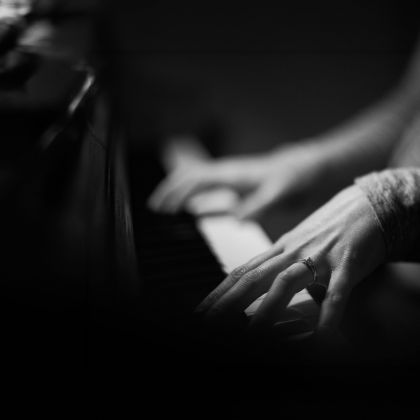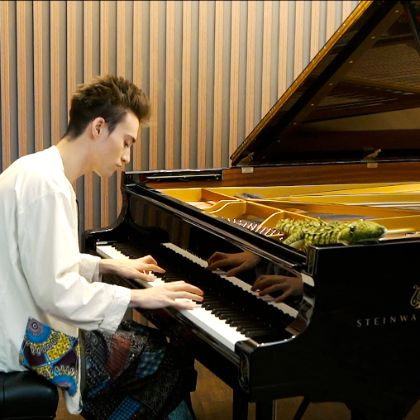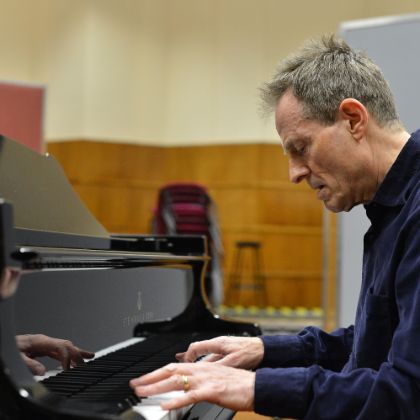Listen Magazine Feature
Pianist Jeffrey Biegel adorns pieces by J.S. Bach with his own ornaments in a solo session for the Steinway & Sons label.
By Bradley Bambarger
Steinway Artist Jeffrey Biegel is warming up — not at the instrument, but in conversation. Taking a break from a solo Bach recording session, his New York–accented rhetorical flight evokes one of John Turturro’s soliloquies from Barton Fink. “People might ask, ‘Isn’t he playing God here, improvising ornaments in Bach’s works?’ I would answer, ‘No, no I’m not. I’m just trying to re-create what Bach might have done had he been able to perform on a modern piano,’ ” Biegel says. “We know he was a great improviser at the keyboard — as all performers were expected to be in the Baroque.”
In June, Biegel recorded his all-Bach album as one of the initial releases, due this fall, by the new label of Steinway & Sons (the parent company of this magazine). Trained by Juilliard pedagogue Adele Marcus in the Romantic tradition, Biegel is venturing into terra incognita for most mainstream pianists, who tend to trail behind period-instrument specialists in the area of Baroque ornamentation, even if stylistic awareness has evolved greatly in recent decades. Among the forty-nine-year-old Long Island native’s previous recordings are his solo piano arrangement of Vivaldi’s Four Seasons (on Naxos) and transcriptions of Christmas carols (Koch), as well as a set of Mozart sonatas featuring his own ornamentation (E1).
The Bach session was held in the Concert Hall of the State University of New York’s Performing Arts Center in Purchase, with Steven Epstein the producer-engineer. The affable and ultra-efficient Epstein — a fifteen-time Grammy-winner in thirty-three years as staff producer at Sony Classical for the likes of Yo-Yo Ma and Joshua Bell — had enough success with Biegel that things ran ahead of schedule. The pianist took advantage of the extra time to explain his method in recording the French Suite in G Major, Partita in C minor and Toccatas in D minor and E minor, plus a couple of major-key sets of Preludes and Fugues from the first book of The Well-Tempered Clavier.
“The French Suite and the Partita are sets of dance movements where Baroque players would have played it straight the first time through and then ornamented the repeats to keep the music fresh and unpredictable,” Biegel says. “To play the repeats the same way would have been unthinkable then, yet many players do it that way today. A lot of people still consider a Bach score like a museum piece — you know, ‘Don’t break it!’ I don’t think that way.
“I hear Bach’s music as virile and passionate,” Biegel continues. “It has not only dignity but a sense of play, and I’m trying to bring that out with a kind of planned improvisation in spots, using various devices: mordants, appoggiaturas, scalar patterns, delayed passing tones and terraced dynamics, along with a variety of touch from detaché to chant-like legato. But I have been judicious. Bach isn’t Couperin or Frescobaldi — the style shouldn’t be as florid. And none of the embellishment should feel tossed-off. Everything should sound organic, worth repeated hearings.”
‘We know Bach was a great improviser at the keyboard — as all performers were expected to be in the Baroque.’
Beyond issues of idiom, Biegel notes the difficulty of maintaining the same intensity in a studio session that he would have in concert: “It’s easier to perform in front of an audience, with the adrenaline it naturally gives you. For me, though, an audience can be just one person, if it’s the right person. And Steven is an ideal listener.”
After a take, Epstein and Biegel discuss the success of the pianist’s ornamentation, whether there was too much or too little, if it came off cleanly enough. Throughout, the challenge is always balancing line with articulation. Biegel stresses that he isn’t aiming to replicate a harpsichord on the piano; he wants the music to sing, as well as dance. The piano is a Steinway Model D, a New York-made “warhorse” from 1980 that Biegel chose out of several in Purchase because, he said, it has “a warmth and wide dynamic range, but also the brightness and bite I was after for Bach.”
In the good old days with Sony, Epstein would have been producing backed by two engineers. Today’s leaner freelance budgets have him working alone, at least for a single-instrument session. Epstein misses the back and forth of a team, yet he also relishes the multiple challenges for a lone technician — monitoring the sound balance, following the performer through the score, keeping track of all the details while also keeping the artist’s spirit up. And Epstein had to listen especially closely at those times when Biegel played off the page, so that he could help judge the ornamentation.
Epstein knows the space, having worked in the Purchase Concert Hall for such albums as Renée Fleming and Brad Mehldau’s Love Sublime. He prefers the venue’s Concert Hall over its smaller recital hall even for solo piano, because “you don’t have to work as hard to get a sound — there’s a bounce to the room.” He worked with two microphones placed fairly close for the main signal, plus two spot mics for more clarity, just in case. Again, the key was balance — not having too much room reverberation in the sound, but not having the piano feel too close and hard, either.
‘The score is just a blueprint, like the blueprint for a room. The blueprint may be perfect, but we still need to adorn the room, decorate it.’
“In a recording of, say, the Brahms sonatas, I would have more distance, more room in the sound,” Epstein explains. “For Bach, I want air around the piano; yet it has to be clear, so that all the polyphony comes through. It’s a fine line. The piano shouldn’t sound percussive, but I know the last thing I’d want to hear is Bach on the piano swimming in some church acoustic.”
Despite his long and starry discography, Epstein hasn’t helmed many sessions of Bach on solo keyboard, but a key experience was with one of the most imposing of Bachians: Rosalyn Tureck. Epstein recalls that it taught him that every artist has his or her peculiar working methods: “It was in 1979, at Columbia’s great old 30th Street Studios. Ms. Tureck didn’t want to be distracted by being able to see anything through the control-room window while she played. So we covered up the window for her. Then a pizza-delivery guy went into the studio by accident and really startled her. We never saw him go in.”
Lunch is a luxury Epstein has long sworn off while working a session, feeling that too much food slows his mental reflexes. So, fueled on coffee and Reese’s Pieces, he explains technical issues while the artist and executive producers are eating; he also sums up Biegel: “Jeffrey has been a discovery for me. He has incredible technique but also real insight into the music. He has something to say, which isn’t always the case.”
Before pianist and producer resume work, they trade anecdotes about a hit album of classically oriented piano pieces. After veering off for a chat about their favorite Gershwin, it’s back to Bach.
On the way to the piano, Biegel offers a metaphor about embellishing Bach’s music: “The score is just a blueprint, like the blueprint for a room. The blueprint may be perfect, but we still need to adorn the room, decorate it. How the room turns out depends on how well the decorator brings it to life. It’s the same when adorning a Bach score with ornamentation. How well it comes out is down to the performer’s taste — and imagination.”
This article originally appeared in Listen: Life with Music & Culture, Steinway & Sons’ award-winning magazine.
related...
-

Practice, Practice, Practice
Steinway Artists on the Rewards of Routine
by Laura Lee Smith
Read More -

Steinway Artist - Jacob Collier: Little Blue
Read More -

Steinway Artist - John Paul Jones
John Paul Jones (born John Baldwin on January 3, 1946) became a prolific music director and arranger of a range of prominent Sixties artists before forming Led Zeppelin with Jimmy Page in 1968. Since 1980, the multi-instrumentalist embarked on a solo career, and his collaborators have included the supergroup Them Crooked Vultures as well as Paul McCartney, Brian Eno, and Diamanda Galas.
Read More